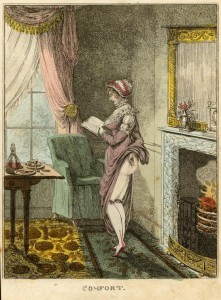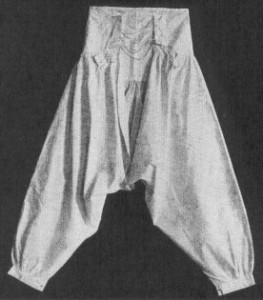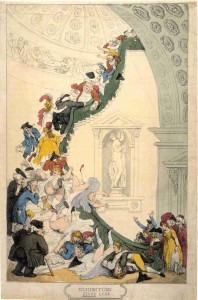I’ve been mulling over ideas for my first “official” post as a Risky, and in the end, I’m falling back on clothing (shocking, I know, LOL!). I thought I’d do a post about “risky” clothing, or drawers. After all, what’s more risky than a risqué garment that we now think of as a necessity!
Knee-length drawers are reported to have been worn by women as early as the turn of the 19th century, but they were considered fast and unladylike, and were not commonly adopted from what I can tell. I’ve consulted with a lot of costume historians and museum curators over the years, and none of them see them as a common garment in the records, household accounts, or as extant garments before the Victorian period, really.
They had a split crotch, usually being made up of two entirely separate legs on a drawstring waistband. An illustration from 1810 (included below) shows a lady wearing them, so it can be construed that they were somewhat accepted by then, but I do wonder as other images in the series seem to concentrate on highlighting the more deceptive aspects of a woman’s toilette (such as wigs).
The extant pairs we DO have from the Regency all seem to date from the 1820s. They have a split crotch, usually being made up of two entirely separate legs on a drawstring waistband.
An illustration from 1810 shows a lady wearing them, so it can be construed that they were becoming more accepted by then, but I would still hazard that they were not a universal.
And I would make that guess because of other images that clearly show them as not being worn (such as Comfort at the top of the post and Exhibition Stare Case, left).
So it’s always worth remembering that the daring, fast, risky move in the Regency period was to put on a pair of drawers. I’d love to see a book where the hero is scandalized by discovering his lady love’s undies, and I fully expect that if anyone can write that book, it’s one of the marvelous women I now share this blog with.
I look forward to seeing what everyone comes up with to talk about in 2015!




